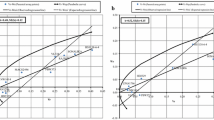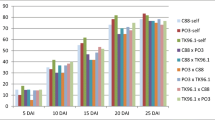Summary
Three partially resistant spring wheat cultivars, with a long latency period were crossed among each other and with the highly susceptible Little Club, with a very short latency period. Parents, F3 and F5 plants have been inoculated with the leaf rust race Flamingo in the young flag leaf stage to determine the latency period. From the crosses with Little Club, it was concluded that Westphal 12A carries three, Akabozu two and BH 1146 two or three genes for a longer latency period. BH 1146 appears to carry also one hypersensitive resistance gene.
Transgressive segregation occurred in crosses between partially resistant cultivars. From crosses between the partially resistant cultivars, it was concluded that the genes in Akabozu and Westphal 12A are different, while those in Akabozu and BH 1146 are at least partly different. The possibilities of accumulation of LP-prolonging genes are discussed.
Similar content being viewed by others
References
Andres M.W., R.D.Wilcoxson & A.P.Roelfs, 1986. Effect of pathogen races on the area under the disease progress curve in barley infected with Puccinia hordei. Z für Pflanzenkr und Pflanzenschutz 93: 632–637.
Broers L.H.M., 1989. Influence of development stage and host genotype on three components of partial resistance to leaf rust in spring wheat. Euphytica 44: 187–195.
Jacobs Th. & L.H.M.Broers, 1989. The inheritance of host plant effect on latency period of wheat leaf rust in spring wheat. I: estimation of gene action and number of effective factors in F1, F2 and backcross generations. Euphytica 44: 197–206.
Johnson R. & A.J.Taylor, 1976. Spore yield of pathogens in investigations of the race-specificity of host resistance. Ann Rev Phytopathology 14: 97–119.
Lee T.S. & G.Shaner, 1985a. Oligogenic inheritance of length of latent period in six slow leaf-rusting wheat cultivars. Phytopathology 75: 636–643.
Lee T.S., & G.Shaner, 1985b. Transgressive segregation of length of latent period in crosses between slow leaf-rusting wheat cultivars. Phytopathology 75: 643–647.
Mather K. & J.L.Jinks, 1982 Biometrical genetics. The study of continuous variation. Third edition. University Press, Cambridge.
Metha Y.R. & J.C.Zadoks, 1970. Urediospore production and sporolation period of Puccinia recondita f. sp. triticina on primary leaves of wheat. Neth J Pl Pathol 76: 267–276.
Niks R.E. & H.J.Kuiper, 1983. Histology of the relation between minor and major genes for resistance of barley to leaf rust. Phytopathology 73: 55–59.
Parlevliet J.E., 1978. Further evidence of polygenic inheritance of partial resistance in barley to leaf rust, Puccinia hordei. Euphytica 27: 369–379.
Parlevliet J.E. & A.vanOmmeren, 1975. Partial resistance of barley to leaf rust Puccinia hordei. II. Relationship between field trials, microplot tests and latent period. Euphytica 24: 293–303.
Parlevliet J.E. & H.J.Kuiper, 1977. Partial resistance of barley to leaf rust, Puccinia hordei. IV. Effect of cultivar and development stage on infection frequency. Euphytica 26: 249–255.
Parlevliet J.E. & H.J.Kuiper, 1985. Accumulating polygenes for partial resistance in barley to barley leaf rust, Puccinia hordei. I. Selection for increased latent period. Euphytica 34: 7–13.
Poyntz B. & P.M.Hyde, 1987. The expression of partial resistance of wheat to Puccinia recondita. Journal of Phytopathology 120: 136–142.
Shaner G. & R.E.Finney, 1980. New sources of slow leaf rusting resistance in wheat. Phytopathology 70: 1183–1186.
Teng P.S., M.J.Blackie & R.C.Close, 1977. A simulation of crop yield loss due to rust disease. Agric Systems 2: 189–198.
Verdoorn, L.R., 1988. Statistical inference on variance components. Ph.D. thesis, Wageningen Agricultural University, ISN 266302, 221 pp.
Yarwood C.E., 1961. Uredospore production by Uromyces phaseoli. Phytopathology 51: 22–27.
Zadoks J.C., 1971. System analysis and the dynamics of epidemics. Phytopathology 61: 600–610.
Author information
Authors and Affiliations
Rights and permissions
About this article
Cite this article
Broers, L.H.M., Jacobs, T. The inheritance of host plant effect on latency period of wheat leaf rust in spring wheat. II: Number of segregating factors and evidence for trangressive segregation in F3 and F5 generations. Euphytica 44, 207–214 (1989). https://doi.org/10.1007/BF00037527
Received:
Accepted:
Issue Date:
DOI: https://doi.org/10.1007/BF00037527




